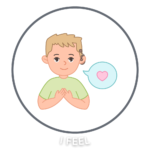
In middle school, students are navigating complex social landscapes, and understanding their friends’ feelings can significantly enhance their interpersonal relationships and overall social success. When teaching middle school students to recognize friend’s feelings, it’s best to have a myriad of activities so you can select lessons based on how your learners learn best.
In this blog post, we will explore a comprehensive lesson plan aimed at helping middle school students recognize their friends’ feelings. This plan includes simple, no-prep games and activities designed to engage students and foster empathy. We’ll also discuss best practices for implementing these activities, ensuring that you can make the most of your time with your students.
Why Recognizing Friend’s Feelings Matters
As you’re teaching middle school students to recognize friend’s feelings, remember this is a crucial skill for middle school students. At this age, peer relationships become increasingly important, and the ability to empathize with others can prevent conflicts and build stronger bonds. Additionally, students who can understand and respond to emotions are better equipped to handle their own emotional challenges, leading to improved mental health and academic performance.
Lesson Plan: Recognizing Friend’s Feelings
Objective
By the end of this lesson, students will be able to identify and articulate the emotions of their peers, demonstrate empathy, and respond appropriately to different emotional states.
Materials Needed
- Whiteboard and markers
- Emotion flashcards (optional, but helpful)
- Space for group activities
Warm-Up Activity: Emotion Charades
Duration: 10 minutes
Instructions:
- Write down different emotions on slips of paper (e.g., happy, sad, angry, confused, excited).
- Divide the class into two teams.
- One student from each team will pick a slip of paper and act out the emotion without speaking.
- The team must guess the emotion within a time limit (e.g., 1 minute).
- Discuss each emotion briefly after it’s guessed, emphasizing the physical cues that helped identify it.
Purpose: This activity helps students become more aware of non-verbal cues associated with different emotions.
Main Activity: Feelings Circle
Duration: 20 minutes
Instructions:
- Arrange students in a circle.
- Start a discussion by asking, “How do you feel today?” and encourage students to share their emotions.
- Use follow-up questions like, “Why do you feel that way?” and “Has anyone else felt the same?”
- Introduce emotion flashcards to help students who struggle to articulate their feelings.
- Encourage students to listen actively and respond with empathy by saying things like, “That sounds tough,” or “I’m glad you’re happy.”
Purpose: This activity fosters an open environment where students can express their emotions and practice empathy.
Group Game: Emotion Matching
Duration: 15 minutes
Instructions:
- Prepare sets of cards with different scenarios and corresponding emotions.
- Divide students into small groups and give each group a set of cards.
- Students must match the scenarios with the appropriate emotions.
- Once matched, each group will explain their choices to the class.
Purpose: This game helps students connect specific situations with the emotions they might provoke, enhancing their understanding of context-based emotional responses.
Cool-Down Activity: Emotion Journal
Duration: 10 minutes
Instructions:
- Provide each student with a journal or a piece of paper.
- Ask them to write about a time when they felt a strong emotion and how their friends responded.
- Encourage them to reflect on how they felt about their friends’ responses and what they learned from the experience.
- If comfortable, invite a few students to share their entries with the class.
Purpose: Journaling allows students to process their emotions and reflect on their interactions, reinforcing the day’s lessons.
Bonus Practice: Everyday Speech Video-Modeling Lesson

Duration: 10 minutes
Instructions:
- Watch the Everybody Has Feelings video lesson
- Check student comprehension with our video companion worksheet (see sample below). Print out or view on screen!

Best Practices for Implementing the Lesson
Create a Safe Space
Ensure that your classroom is a safe and supportive environment where students feel comfortable sharing their feelings. Establish ground rules for respectful listening and confidentiality to encourage openness.
Use Positive Reinforcement
Praise students for their efforts in recognizing and responding to emotions. Positive reinforcement can boost their confidence and motivation to engage in these activities.
Be Patient and Observant
Recognizing and articulating emotions can be challenging for some students. Be patient and offer gentle guidance as needed. Pay attention to students who may struggle and provide additional support or alternative methods to help them participate.
Encourage Ongoing Practice
Incorporate short activities related to recognizing friends’ feelings into your regular sessions. Consistent practice helps reinforce these skills and makes them a natural part of students’ interactions.
Unlock ALL of our visual tools and posters by signing up for your free trial today – no credit card required!
Access the full Social Communication Curriculum HERE!
Instant access to thousands of no-prep social skills activities, over 1000+ video lessons, and engaging games designed to enhance learning and development.
Sample Video
Students learn best from watching real students their own age model skills. Try out this sample video lesson. We offer our entire Social-Emotional Learning platform free for 14 days here!
Related Blog Posts:
Lesson Plan: Identifying Feelings
Lesson Plan: Changing the Channel on Feelings
Free Identifying Feelings Material





